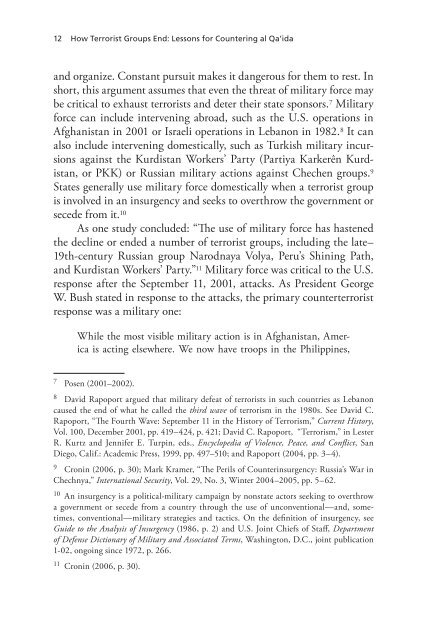How Terrorist Groups End - RAND Corporation
How Terrorist Groups End - RAND Corporation
How Terrorist Groups End - RAND Corporation
Create successful ePaper yourself
Turn your PDF publications into a flip-book with our unique Google optimized e-Paper software.
12 <strong>How</strong> <strong>Terrorist</strong> <strong>Groups</strong> <strong>End</strong>: Lessons for Countering al Qa’ida<br />
and organize. Constant pursuit makes it dangerous for them to rest. In<br />
short, this argument assumes that even the threat of military force may<br />
be critical to exhaust terrorists and deter their state sponsors. 7 Military<br />
force can include intervening abroad, such as the U.S. operations in<br />
Afghanistan in 2001 or Israeli operations in Lebanon in 1982. 8 It can<br />
also include intervening domestically, such as Turkish military incursions<br />
against the Kurdistan Workers’ Party (Partiya Karkerên Kurdistan,<br />
or PKK) or Russian military actions against Chechen groups. 9<br />
States generally use military force domestically when a terrorist group<br />
is involved in an insurgency and seeks to overthrow the government or<br />
secede from it. 10<br />
As one study concluded: “The use of military force has hastened<br />
the decline or ended a number of terrorist groups, including the late–<br />
19th-century Russian group Narodnaya Volya, Peru’s Shining Path,<br />
and Kurdistan Workers’ Party.” 11 Military force was critical to the U.S.<br />
response after the September 11, 2001, attacks. As President George<br />
W. Bush stated in response to the attacks, the primary counterterrorist<br />
response was a military one:<br />
While the most visible military action is in Afghanistan, America<br />
is acting elsewhere. We now have troops in the Philippines,<br />
7 Posen (2001–2002).<br />
8 David Rapoport argued that military defeat of terrorists in such countries as Lebanon<br />
caused the end of what he called the third wave of terrorism in the 1980s. See David C.<br />
Rapoport, “The Fourth Wave: September 11 in the History of Terrorism,” Current History,<br />
Vol. 100, December 2001, pp. 419–424, p. 421; David C. Rapoport, “Terrorism,” in Lester<br />
R. Kurtz and Jennifer E. Turpin, eds., Encyclopedia of Violence, Peace, and Conflict, San<br />
Diego, Calif.: Academic Press, 1999, pp. 497–510; and Rapoport (2004, pp. 3–4).<br />
9 Cronin (2006, p. 30); Mark Kramer, “The Perils of Counterinsurgency: Russia’s War in<br />
Chechnya,” International Security, Vol. 29, No. 3, Winter 2004–2005, pp. 5–62.<br />
10 An insurgency is a political-military campaign by nonstate actors seeking to overthrow<br />
a government or secede from a country through the use of unconventional—and, sometimes,<br />
conventional—military strategies and tactics. On the definition of insurgency, see<br />
Guide to the Analysis of Insurgency (1986, p. 2) and U.S. Joint Chiefs of Staff, Department<br />
of Defense Dictionary of Military and Associated Terms, Washington, D.C., joint publication<br />
1-02, on going since 1972, p. 266.<br />
11 Cronin (2006, p. 30).

















